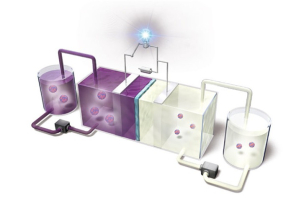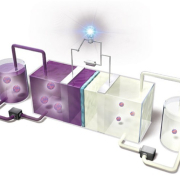First Assembly of a Uranium-Based Rechargeable Battery
Mar. 13, 2025

Key Highlights:
- Uranium has unique chemical properties and has long been recognized as a candidate for active materials in chemical batteries.
- In this research, we developed the first “uranium rechargeable battery” that utilizes the chemical properties of uranium for practical use and verified its performance in charging and discharging.
- These results are expected to provide a new resource value to “depleted uranium,” which is generated in nuclear fuel production and unutilized in the immediate future. The uranium-based rechargeable battery has the potential to be a power control for renewable energy generations such as mega-solar power plants, contributing to the realization of a decarbonized society.
Overview:
- Uranium has been considered a promising active material for rechargeable batteries due to its unique chemical properties. In this research, we successfully developed a rechargeable battery using uranium as an active material. Here, we firstly verified the charge and discharge performance of the uranium-based battery. We are now developing flow cells, including electrodes for higher capacity (redox flow battery) and the system for circulating electrolytes (solution dissolving active materials), to promote these results for practical use.
- During nuclear fuel production, “depleted uranium (DU)” is generated as a byproduct. Since DU cannot be used as fuel in current nuclear reactors (light water reactors), approximately 16,000 tons of DU are stored in Japan. To utilize DU as a new resource, the concept of rechargeable batteries using uranium as an active material was proposed in the early 2000s. However, no studies were reporting the specific performance of the assembled uranium rechargeable batteries.
- Meanwhile, the need for rechargeable batteries has been increasing in recent years with an increase in the introduction of renewable energy sources. Power generation from solar, wind, and other sources is affected by weather conditions and has the instability of fluctuating power generation. To stabilize the power supply in this situation, output controls via energy storage devices such as rechargeable batteries are necessary, and the development of new energy storage technologies is attracting attention.
- From this background, the research team developed a rechargeable battery using uranium as the active material (uranium rechargeable battery) and clarified its charging-discharging performance for the first time. The uranium storage battery utilizes uranium as the negative electrode active material and iron as the positive one. The single-cell voltage of the prototype uranium rechargeable battery was 1.3 volts, which is close to that of a common alkaline battery (1.5 volts). The battery was charged and discharged 10 times, and the performance of the battery was almost unchanged, indicating relatively stable cycling characteristics.
- If uranium rechargeable batteries are increased in capacity and put to practical use, the large amount of DU stored in Japan will become a new resource for output controls in the electricity supply grid derived from renewable energy, thereby contributing to the realization of a decarbonized society.
- This research was conducted by Assistant Principal Researcher Dr. Kazuki Ouchi, Researcher Dr. Katsuhiro Ueno, and Senior Principal Researcher Dr. Masayuki Watanabe of the Special Team for Battery Energy Storage, NXR Development Center, Nuclear Science Research Institute at the Japan Atomic Energy Agency (JAEA; President: Masanori Koguchi). Based on this work, a patent application was filed on November 29, 2024 (Patent Application No. JP2024-209096).
Source:First Assembly of a Uranium-Based Rechargeable Battery | Press Releases | Japan Atomic Energy Agency




